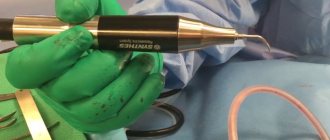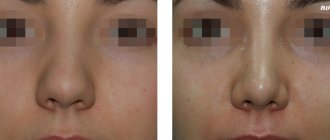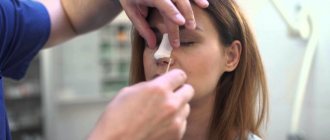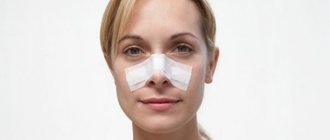One of the most common surgical operations associated with aesthetic correction of appearance is rhinoplasty. Considering that “The face is everything that is built around the nose,” deciding whether to undergo rhinoplasty is very difficult - after all, we are talking about a surgical operation, which many associate with pain and the risk of possible complications. Some ridiculous articles from the global network and common myths about rhinoplasty, which introduce additional fears and confusion into the heads of patients, contribute to the difficulty of making a decision about surgery. Let's look at some.
Myth No. 1. Rhinoplasty can be performed by any plastic surgeon.
Technically yes. Many plastic surgeons have rhinoplasty on their list of services. However, this does not mean that every surgeon can do it at the proper level. Rhinoplasty is a complex operation, both from an aesthetic and functional point of view. A good rhinosurgeon must have an excellent understanding of the internal anatomy of the nose and the functioning of the respiratory system, since nose correction changes not only aesthetic, but also functional parameters - breathing. On the other hand, no other anatomical formation affects the perception of the face as a whole as much as the nose. Therefore, a plastic surgeon involved in nose correction must have a developed aesthetic sense, which will help him achieve the best aesthetic result, taking into account the preservation or restoration of external respiratory function.
Columella changes during rhinoplasty
The goal of a plastic surgeon is not only to correct a specific defect, but also to maintain the overall harmony of the nose and face, and to do this in the simplest possible way. Sometimes the columella of the nose has an irregular shape, but working with it will not make the face beautiful, but, on the contrary, will make other features more obvious.
Therefore, sometimes, to correct the nasal column, the doctor can make a volumetric correction, based on the structure of the nose of the person who came to the plastic surgery clinic. The doctor can change the tip of the nose, lift it higher, thereby tightening the columella. Sometimes plastic surgery of the wings of the nose is effective when the surgeon moves them higher, so the column, remaining in the same place, becomes visually lower.
Therefore, preparation for surgery is a productive collaboration between the patient, who must explain what result of the surgical intervention he wants to see, and the doctor, who knows the structure of the nose and the person and understands what results and what methods can be achieved.
Myth No. 4. Computer modeling does not allow one to accurately predict the outcome of the operation.
Computer modeling of rhinoplasty is a good tool to determine the shape of the future nose. It is important that the simulation is carried out by the surgeon himself, since at this stage the doctor outlines a plan for the future operation and clarifies which technique is best to use to achieve the desired result. Of course, the result of the operation may differ from the computer model, since nasal tissue is not an ideal plastic material such as clay or plasticine. The processes of tissue restoration and scarring are very individual and not always predictable. The patient must be aware of this. However, modern rhinoplasty cannot be imagined without computer modeling.
Can everyone have rhinoplasty?
Like all surgical interventions, rhinoplasty is associated with a certain risk to the health, and even the life of the patient, so the question of whether or not to resort to the help of a plastic surgeon must be answered after carefully considering everything.
If, due to an old injury or a deviated nasal septum, the nose cannot fully perform respiratory functions, surgery is necessary. And here medical indications come to the fore. But what about those who are simply dissatisfied with their own respiratory system? Correct its shape?
Unfortunately, not all dissatisfied people are allowed surgical intervention, however, just like not all cosmetic defects can be corrected with rhinoplasty.
Having decided to try their luck with plastic surgery, future patients should be prepared for the procedure:
Consult with a therapist about individual contraindications for surgery. Not everyone knows that patients with chronic renal failure, diabetes mellitus, gastrointestinal pathologies, autoimmune and oncological diseases, as well as mental disorders are strictly contraindicated for such surgical intervention.
Be clear about what you want in the end, and be aware that, despite the skill of the surgeon, the anatomical features of your nose can significantly affect the final result.
Carefully choose the clinic where the procedure will take place and decide on the identity of the doctor to whom you can entrust your future irresistibility.
Conduct mandatory laboratory and clinical examinations, as well as carefully examine the anatomical and functional parameters of the respiratory organ using CTG and X-ray examination.
After a successful operation, strictly follow the advice of a specialist.
Myth No. 6. “Everyone will immediately understand that I had surgery”
What's wrong with that? You are working on yourself, and, in my opinion, you are worthy of respect. If before the operation the nose had pronounced defects - a large hump, an axial curvature, a significant length, then those around you can notice such changes immediately. If the operation performs only the correction of small defects, for example, changing the tip of the nose or minimal correction of the entire nose, then for most the fact of the operation will go unnoticed. Only we ourselves know our face well, so plastic surgery is done, first of all, for ourselves, and not for everyone else.
Psychological consequences of rhinoplasty
Rhinoplasty is performed for a wide range of functional and aesthetic indications. Patients with functional problems rate rhinoplasty as successful when respiratory function improves.
The aesthetic goal of rhinoplasty is to increase the patient's self-confidence. However, the patient's expectations may be unrealistic and beyond the surgeon's capabilities.
Psychoneurotic disorders (neurosis) appear when the patient has a real complaint or deformation, but exaggerates its significance. This psychological disorder does not cause problems when the patient is treated in a gentle and caring manner.
Psychotic disorders are noted when the patient describes a functional or cosmetic abnormality that does not exist or exists only to some extent. In this case, consultation with a psychiatrist is necessary.
Myth No. 7. Rhinoplasty is painful
A fairly common myth is that rhinoplasty is a painful operation. If we compare this operation, for example, with breast augmentation or abdominoplasty, we can say that it is painless. Moreover, with the availability of modern methods of anesthesia, this issue can be considered irrelevant. The operation is performed in a state of medicated sleep, and the patient does not feel anything. In the postoperative period, patients are more concerned about tampons in the nasal cavity, which are removed the next day after surgery, and swelling around the eyes, which disappear within 2 weeks. Rhinoplasty is not painful at all.
The dangers of rhinoplasty - we assess the risks of complications
When turning to a plastic surgeon to correct the shape of the nose, many expect, if not a miracle, then an immediate and certainly guaranteed effect. Rhinoplasty is a part of plastic surgery in which the same rules, patterns and probabilities apply as in any surgical intervention.
Are there any real risks to rhinoplasty—the risk of certain and mostly predictable health or appearance consequences? No conscientious surgeon will convince the patient that the operation is very simple, and that guarantees can be given for its successful completion and subsequent planned result.
Surgery, like all medicine, is not an exact science. It does not give a result guaranteed by calculations, and the surgeon can only give you statistics that indicate the likelihood of complications. Plastic surgery is characterized by the use of minimal risk techniques, since the operation itself is most often justified by indications that are not critical to life and health. Rhinoplasty, like blepharoplasty and other surgical methods for correcting appearance, can be used specifically for aesthetic and psychological purposes.
Myth No. 8. Rhinoplasty is done only by those who are concerned about their appearance
There is an opinion that rhinoplasty is only an aesthetic operation that changes the shape of the nose, but it is unacceptable to make a beautiful nose proportional to the face that “will not breathe.” In my practice, I often combine two operations in one - rhinoplasty and septoplasty (plasty of the nasal septum).
A well-performed rhinoplasty helps improve self-esteem and emotional well-being, which significantly improves the patient’s quality of life. However, you cannot count on the fact that rhinoplasty will allow you to return or acquire a husband or wife, although the chances in such matters often increase 
These are the most common myths about rhinoplasty, but there are others. Do not increase the number of myths by trying to obtain information from unreliable sources; ask questions directly during a consultation with a professional plastic surgeon.
Clear knowledge and a positive attitude are the best way to a new appearance.
Risks of Nose Surgery Rhinoplasty
After rhinoplasty, most patients experience side effects such as bleeding, soreness, bruising, swelling, redness and discomfort. These are all within normal limits and will subside within a few weeks of the procedure. Some side effects, such as prolonged numbness and swelling of the tip of the nose and upper lip, may last much longer, up to 1 or 2 years. After surgery, you may experience complications such as slow healing or adverse reactions to medications or anesthesia. After rhinoplasty, blood vessels in the nose may burst and fine red lines may appear on the surface of the skin of the nose. Although they tend to go away over time, there is a chance that they will remain permanently. As with any surgical procedure that requires cutting into the skin, infection is possible, but the risk is very low - only about one percent. Significant swelling, redness, warmth, or pain in the nose are signs of infection. Skin dying is also possible. In non-smokers, the possibility of such a phenomenon is much lower than in patients who smoke. Long period of healing of hematomas. The most expected postoperative complication is a long period of hematoma healing, which can last for several months after nasal surgery. This especially applies to smokers, as smoking can make the healing process longer. Many patients find swelling to be the most long-lasting side effect. Some residual swelling after rhinoplasty can last up to six weeks. Since rhinoplasty requires incisions in the skin, scarring is possible. However, since the incisions are made inside the nostrils and the skin dividing the nostrils, the risk of visible scarring is very low. Risks of the Recovery Period If the nose is damaged during the recovery process, it may become misaligned, malformed, crooked, or asymmetrical. This may lead to repeat surgery. In addition to aesthetic problems with the nose after surgery, structural or functional complications are also included in the list of surgical risks. Loss of structural support, breathing problems, deviated septum, recurring nosebleeds, and permanent or temporary numbness are possible risks of rhinoplasty. When rhinoplasty is performed by an experienced and qualified plastic surgeon, the likelihood of complications is very low and complications are usually minor. However, any surgical procedure has a risk of complications, which should be discussed with your surgeon before planning the procedure. If you carefully follow your surgeon's instructions during preparation for surgery and during recovery, you can minimize your risks. Risks in the late postoperative period If the nose is curved to the left or right, this means that the nasal septum has some kind of abnormality, congenital or post-traumatic. Nasal deformity may return to a lesser extent in 20% of cases after revision nose surgery. This mainly depends on the stiffness of the cartilage and is impossible to predict in advance. Nostril asymmetry is another big problem that worries patients. It mainly depends on facial asymmetry and does not improve after surgery. If you would like more information about nose surgery in Yerevan, Armenia, click here to visit our FAQs or contact our office to schedule a consultation with Dr. Karen Danielyan. In addition to other articles on nose surgery, ArzniAesthetica.com contains numerous resources, including a gallery of before and after photos, and other useful information about this popular procedure that may be of interest to our patients.
Rhinoplasty: Pros and Cons
Attractiveness, aesthetic beauty and flawlessness of the face are important for every person. For women in particular. Some people get beauty from birth, others have to fight for it.
Rhinoplasty is a smart solution that allows you to:
- get rid of nasal defects;
- eliminate imperfections and defects in appearance;
- remove crooked nose;
- restore normal respiratory functions.
But before agreeing to the operation, you need to study all the pros and cons of rhinoplasty. Still, this is not a joke, but a serious surgical intervention. And you need to approach it with responsibility and seriousness.
Although in general, of course, the popularity of rhinoplasty is growing. This is greatly facilitated by the reduction in prices for facial (nose) plastic surgery.
Rhinoplasty for health
Plastic surgery on the nose (how it is done) can have more than just aesthetic goals. Surgery often allows you to restore healthy nasal function and straighten the nasal septum.
Rhinoplasty today can be prescribed by an otolaryngologist (ENT) as an optional, but very desirable procedure. In extreme situations, such intervention is inevitable (in case of injuries).
That is, by agreeing to rhinoplasty, you can count on a double effect:
- on the aesthetic result;
- for medical and health benefits.
Select and model on a computer
Special computer software used in medicine makes it possible to:
- enter the patient’s physiometric data into the computer;
- simulate the optimal shape of the nose;
- print a ready-made potential photograph of a face;
- Provide the patient with a picture of what he will look like after surgery.
There is nothing to be afraid of here. The doctor’s experience and professionalism guarantee a positive outcome of the event. In addition, before the operation begins, the patient undergoes all the necessary examinations and tests. And this eliminates any deviations from the planned plan.
If the patient feels unwell, rhinoplasty is postponed.
Open and closed rhinoplasty
In each individual case, the doctor chooses one way or another. Open rhinoplasty, on one side:
- provides ease of maneuver;
- expands the range of doctor’s capabilities;
- simplifies the operation.
On the other hand, external incisions take longer to heal and leave a small mark. But over time, all scars disappear.
Closed rhinoplasty also has advantages:
- heals faster;
- leaves no external marks;
and disadvantages:
- difficulty of maneuvering;
- constraint of the surgeon's actions.
Risks and dangers of rhinoplasty
The main thing here is to choose the right professional doctor. The outcome of the entire operation depends on the qualifications of the surgeon. It is better to find an experienced specialist who you can trust 100%. And you can’t save money here!
With rhinoplasty (if the doctor makes mistakes), the following are possible:
- subsequent nosebleeds;
- infectious infection;
- unsatisfactory results of the operation.
Surgical intervention (in case of failure or errors) can be repeated. And you can avoid such problems by contacting a competent specialist - a plastic surgeon with an impeccable reputation.
Rhinoplasty is not recommended and is contraindicated for people:
- those who have not reached adulthood (when the body is still being formed);
- those suffering from low blood clotting;
- suffering from infectious diseases.
It takes a long time to evaluate the effect of rhinoplasty. Usually the result is assessed only after a year. Recovery here is a complex and lengthy process. During treatment, the person should be removed from heavy physical labor.
Yes or no
No matter what they say, rhinoplasty is a serious decision. Do you need this specifically? Is surgery necessary? Is it possible to brighten up and hide external flaws with cosmetics? Are you ready to take risks? All these questions need to be thought through carefully. The operation is complex, its risks are high, so it is better not to rush into a decision.









